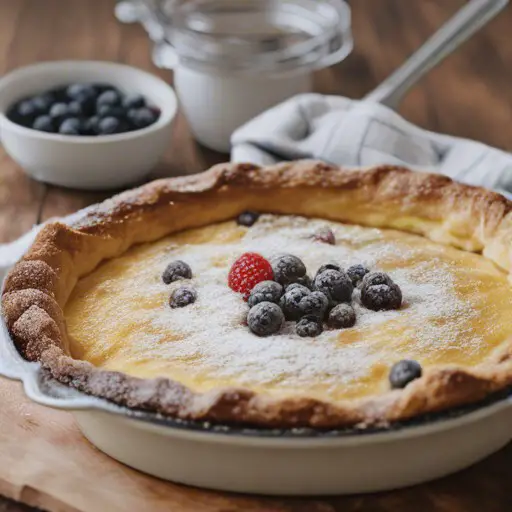Step into the enchanting world of Dutch Baby Bake, where simplicity meets elegance in a spectacular display of flavors and textures. This pancake-like creation, often referred to as a German pancake, delights both the eyes and the palate. Join us on a culinary adventure as we unveil the secrets behind the Dutch Baby Bake – a show-stopping dish that effortlessly transforms your breakfast or brunch into a feast fit for royalty.

Ingredients:
- 3 large eggs
- 3/4 cup all-purpose flour
- 3/4 cup whole milk
- 1 tablespoon granulated sugar
- 1 teaspoon vanilla extract
- 1/2 teaspoon salt
- 3 tablespoons unsalted butter
Instructions:
- Preheat and Prep:
- Preheat your oven to 425°F (220°C).
- In a blender, combine eggs, flour, milk, sugar, vanilla extract, and salt. Blend until smooth.
- Butter Up:
- Place the unsalted butter in a 10-inch cast-iron skillet or oven-safe pan. Melt the butter in the preheated oven until it’s bubbling.
- Batter Pour:
- Carefully pour the blended batter into the hot, melted butter in the skillet.
- Bake to Perfection:
- Bake in the preheated oven for 20-25 minutes or until the Dutch Baby is puffed, golden brown, and beautifully set in the center.
- Serve Immediately:
- Remove from the oven and serve immediately. The Dutch Baby will begin to deflate shortly after being taken out of the oven.
Cook Notes and Variations:
Cooking Tips:
- For a citrusy twist, add a teaspoon of lemon zest to the batter.
- Experiment with different extracts such as almond or orange for unique flavor profiles.
Variations:
- Fruit Finesse: Top the Dutch Baby with fresh berries, sliced peaches, or a sprinkle of powdered sugar for a fruity delight.
- Savory Sensation: Incorporate shredded cheese, sautéed mushrooms, or herbs into the batter for a savory version.
Keto and Low-Carb Versions:
For Keto Enthusiasts:
- Substitute all-purpose flour with almond flour or coconut flour for a lower-carb alternative.
- Use a sugar substitute like erythritol or monk fruit sweetener instead of granulated sugar.
Low-Carb Modification:
- Adjust the quantity of flour to reduce the carb content.
- Choose a low-carb milk substitute, such as almond or coconut milk.
Frequently Asked Questions (FAQs):
Q1: Why is it called a Dutch Baby? A1: Despite its name, the Dutch Baby has German origins. The term “Dutch” likely evolved from the Pennsylvania Dutch (Deutsch) immigrants who brought similar recipes to the United States.
Q2: Can I use a different type of pan if I don’t have a cast-iron skillet? A2: While a cast-iron skillet is traditional, you can use an oven-safe pan or even a baking dish. Ensure it’s preheated with melted butter before pouring in the batter.
Q3: Can I make a Dutch Baby ahead of time? A3: Dutch Baby is best enjoyed fresh out of the oven, as it starts to deflate shortly after baking. However, you can prepare the batter in advance and refrigerate it until ready to bake.
Q4: Why did my Dutch Baby not puff up? A4: Several factors can affect the rise of a Dutch Baby, including oven temperature and freshness of ingredients. Ensure your oven is fully preheated, and use fresh eggs and baking powder.
Q5: Can I add spices like cinnamon or nutmeg to the batter? A5: Absolutely! Experiment with your favorite spices to customize the flavor profile of your Dutch Baby. Cinnamon, nutmeg, or a pinch of cardamom can add delightful nuances.

As we conclude our exploration of the Dutch Baby Bake, we find ourselves immersed in the allure of a dish that effortlessly marries simplicity with sophistication. This pancake’s theatrical rise in the oven and its golden, pillowy perfection make it not just a breakfast item but a centerpiece of culinary artistry.
Whether you choose to enjoy it with a dusting of powdered sugar and a squeeze of lemon or go for a savory variation with cheese and herbs, the Dutch Baby Bake is a canvas waiting for your creative touch. So, preheat that oven, whip up a batter, and let the magic unfold in your kitchen. Happy baking!
